Are you a Quiet Speculation member?
If not, now is a perfect time to join up! Our powerful tools, breaking-news analysis, and exclusive Discord channel will make sure you stay up to date and ahead of the curve.
Editor's note: 2019 was perhaps Modern's wildest year ever, featuring such meta-defining decks as UR Phoenix, Hogaak, and Whirza thanks to monumental shakeups in the form of Modern Horizons and other expansions. That chaos wasn't without its constants, including one critical element of new spoilers: card evaluation. In this re-run of my favorite self-published article this year, we'll review how to tell the good from the bad among efficient damage machines. Happy holidays, and here's hoping we get plenty of Delver analogues in the new year!
Core Set 2020 spoilers are under way, and a couple cards have already caught my attention. The one we'll discuss today is Elvish Reclaimer, a potential 3/4 for one mana... with upside! But can its drawbacks be mitigated effectively? Let's find out by comparing Reclaimer to Modern's other one-mana combat creatures, seeing in the process what the format necessitates for these cards to succeed.
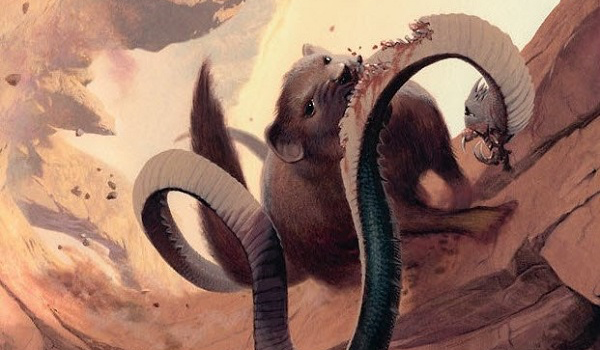
While my previous work on combat creatures has included aggro standbys like Goblin Guide and Monastery Swiftspear, this article focuses solely on the beefiest one-drops: the ones that both attack and block with gusto (read: the magic number 3). Sorry, Kird Ape!
Cost vs. Reward: The Former
This article's about one-drops, or creatures that cost a single mana. But truly proficient combat creatures this cheap are tough to come by in Modern, a format defined by the bulk of its beaters. While they may all cost one mana, the threats discussed here tax pilots in other ways—either when it comes to casting them or maximizing them.
Resources Needed
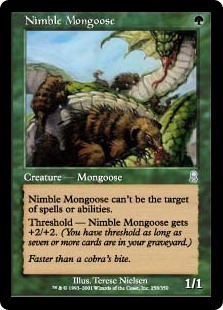 Magic is a game of resources, of which boundary-pushing card design ensures there are plenty of. Mana is but one such resource, if the most obvious; others include cards in the graveyard (Nimble Mongoose), land types in play (Wild Nacatl), life not had below a certain number (Death's Shadow), or number of cards discarded this turn (Hollow One).
Magic is a game of resources, of which boundary-pushing card design ensures there are plenty of. Mana is but one such resource, if the most obvious; others include cards in the graveyard (Nimble Mongoose), land types in play (Wild Nacatl), life not had below a certain number (Death's Shadow), or number of cards discarded this turn (Hollow One).
Resources needed refers to the resources players must have available to deploy a given threat, as with mana; a one-mana spell, for instance, requires one land in play to cast. That land is not consumed by the spell, and can be tapped again next turn.
Resources Used
By contrast, resources used refers to the resources players must expend to deploy a given threat. In this case, the land is indeed spent, as by Scythe Tiger. This steep cost has always prevented Scythe Tiger from seeing Modern play in any capacity.
An apt comparison exists between Nimble Mongoose, which needs cards in the graveyard to become 3/3, and Hooting Mandrills, which spends cards in the graveyard. Multiple Mongeese can be dropped into play with seven cards in the graveyard; with just five, players may cast only one Mandrills for one mana.
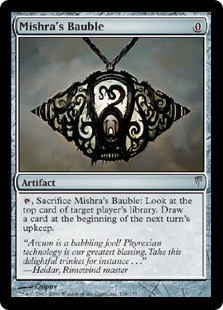 Casting Time
Casting Time
A subtler contributor to playability is casting time, or flexibility regarding when players must invest mana into their creature. Consider Hooting Mandrills, a threat that requires five cards in the graveyard to be cast for one mana. Playing Mandrills on turn one is not really feasible in Modern. Doing so on turn two is much easier, especially given something like Thought Scour. Assuming two land drops, both fetches, even Gurmag Angler is castable turn two with a Scour. Grixis Shadow decks aren't interested in taking chances, though, and like to have mana up for Stubborn Denial when possible, so they've come to include Mishra's Bauble to mitigate the casting time requirement of their delve threat.
Grixis Shadow, by Rayton Espiritu (8th, SCG Louisville Classic)
Grixis Shadow employs a similar strategy with Death's Shadow, its namesake one-mana beater. Shadow can't be cast on turn one, either; pilots must first drop themselves to below 13 life. Hence the deck's painful manabase and use of additional enablers like Street Wraith—and all to increase casting time flexibility. Looking at the opposite end of the spectrum, Champion of the Parish is another build-around one-drop that must be cast at a specific time to achieve its potential: in this case, before other creature spells, or as early as possible. 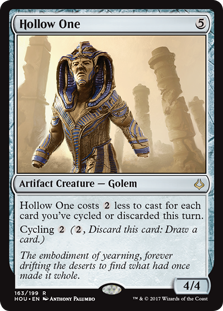 Similarly, Hollow One prices players into spending mana on the Golem during turns they discard spells, even if they've drawn another juicy castable off their Goblin Lore (say, Fatal Push). In lieu of another looting spell, they may otherwise miss out on the chance to cast their creature at all.
Similarly, Hollow One prices players into spending mana on the Golem during turns they discard spells, even if they've drawn another juicy castable off their Goblin Lore (say, Fatal Push). In lieu of another looting spell, they may otherwise miss out on the chance to cast their creature at all.
Like Gurmag Angler, Nimble Mongoose asks for a certain number of cards in the graveyard before it assumes its final form for one mana. Granted, Mongoose solicits more cards than Mandrills or Angler; players will be hard-pressed even to have Mongoose swinging for 3 on turn two. But Mongoose beats the delvers on casting time, as pilots can cast Mongoose as of turn one.
In "Tough as Nails: Combat, Removal, and Stats," I conceptualized this principle by sorting creatures into stages—that is, the part of the game they become live. More flexible creatures, like Mongoose, fall into earlier stages. Other Stage 1 creatures include Wild Nacatl and now Elvish Reclaimer; besides the missed combat steps shared by all late-cast creatures, and the fact that late-game boards may prove more hostile to smaller threats, these beaters don't lose or gain anything from being cast at a certain time or not. Their casters then enjoy more choice about how to invest their mana, enabling lines like two-mana follow-up plays.
Cost vs. Reward: The Latter
On to our spoils, or what we get for casting the creature at all.
Stats
Stats tend to be the single most important factor when determining the playability of combat creatures. No way Hollow One would headline a deck at 3/4, or that Wild Nacatl would have ever eaten a ban at 3/2. That's why the most-played one-mana combat creatures are the biggest ones: Gurmag Angler; Death's Shadow; Hollow One.
Abilities
There are three types of abilities creatures can have: evasion, utility, and static. Evasion abilities, such as trample on Hooting Mandrills, let them penetrate enemy defenses. Utility effects provide some additional benefit to the caster, like Tasigur's Cruelty's activated ability. And static ones vary from creature to creature: the main draw to Nimble Mongoose, for instance, is its shroud keyword, which protects it from enemy removal; Death's Shadow, on the other hand, has the ability to grow larger at will when pilots are sitting behind a fetchland, or perhaps gripping a Street Wraith.
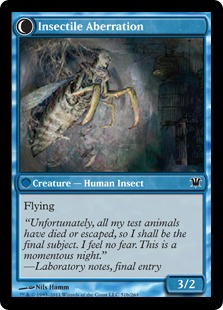 Evasion keywords are becoming increasingly common on cheap combat creatures, but they often replace raw stats, a bad trade for our purposes. Hooting Mandrills and Delver of Secrets // Delver of Secrets are the only one-drops in Modern with 3 or more power and an evasion ability.
Evasion keywords are becoming increasingly common on cheap combat creatures, but they often replace raw stats, a bad trade for our purposes. Hooting Mandrills and Delver of Secrets // Delver of Secrets are the only one-drops in Modern with 3 or more power and an evasion ability.
Utility is even rarer on a one-mana combat creature, as these are already pushed to begin with. But they do exist; a solid recent example is Hexdrinker, which arrives as a just-okay 2/1 but boasts the ability to grow larger should players have extra mana sitting around. Such abilities again tend to cannibalize stats—creatures can only do so much for one mana.
Static abilities on one-drop combat creatures often take the form of drawbacks, lowering the overall reward for producing the threat in question; the aforementioned Mongoose and Shadow theoretically provide exceptions to this rule, but both of them also contain static-ability text that limits their reliability as large beaters.
Durability
The final factor to assess is durability, or the odds of a threat staying on the battlefield to do combat once resolved. Protective keywords like Mongoose's shroud contribute favorably to this metric, but don't quell the threat of damage-based sweepers such as Anger of the Gods. Stats do, though, and every point matters, especially with Gut Shot, Collective Brutality, Lightning Bolt, Flame Slash, and Lightning Axe all co-existing at Modern's top tables.
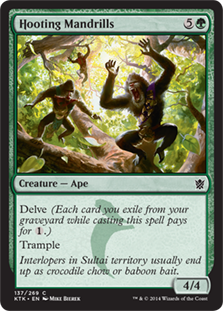 Of course, some removal spells slaughter beaters regardless of toughness, which is where converted mana cost enters the equation. Fatal Push may have damaged the rep of Modern's premier combat creature, but it can't touch Hollow One or the delve creatures, making such threats attractive ways to punish opponents looking to chop up Goyfs on the cheap.
Of course, some removal spells slaughter beaters regardless of toughness, which is where converted mana cost enters the equation. Fatal Push may have damaged the rep of Modern's premier combat creature, but it can't touch Hollow One or the delve creatures, making such threats attractive ways to punish opponents looking to chop up Goyfs on the cheap.
Another element of durability lies with a threat's reliability over time. Turn-two Hooting Mandrills could care less about a subsequent Rest in Peace, but copies in hand are functionally blanked by the enchantment resolving. And Nimble Mongoose is rendered an eternal 1/1 no matter where it finds itself when Rest comes down. In this sense, delve creatures are more robust than those that check the graveyard from the battlefield, as ones quickly deployed can sidestep the hate.
Evaluating Elvish Reclaimer
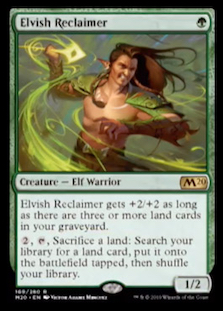 With the metrics for playability among one-mana beaters clearly outlined, we can apply this theory to existing creatures in Modern. In terms of cost, Nimble Mongoose is potentially a 3/3 with shroud that leaves used resources intact and can be played at any time. So why doesn't it see any action? Because of its low reward: Mongoose is slower than Mandrills or Angler at getting in for full damage, always soft to the common practice of graveyard nuking, vulnerable to popular sweepers despite the shroud, and with no evasion, outclassed by many of Modern's creatures. Let's apply these same principles to newcomer Elvish Reclaimer and see how the Warrior ranks.
With the metrics for playability among one-mana beaters clearly outlined, we can apply this theory to existing creatures in Modern. In terms of cost, Nimble Mongoose is potentially a 3/3 with shroud that leaves used resources intact and can be played at any time. So why doesn't it see any action? Because of its low reward: Mongoose is slower than Mandrills or Angler at getting in for full damage, always soft to the common practice of graveyard nuking, vulnerable to popular sweepers despite the shroud, and with no evasion, outclassed by many of Modern's creatures. Let's apply these same principles to newcomer Elvish Reclaimer and see how the Warrior ranks.
Cost
Resources needed: Reclaimer asks for three lands in the graveyard. Fetch, fetch, fetch, done! But in this case, a turn-one Reclaimer can't attack for 3 until turn three, and that's only if players make three consecutive land drops... all of them fetches. Players looking to get aggressive early will need some other engine to get the gears moving. Faithless Looting and Thought Scour seem like natural enablers, but neither guarantees a "flip," and neither is free, functionally increasing the Elf's mana demands.
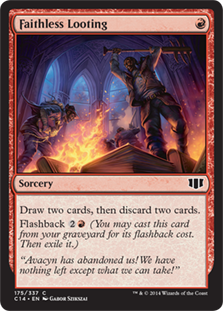 Resources used: None. Flying colors on this one.
Resources used: None. Flying colors on this one.
Casting time: Reclaimer is clearly a Stage 1 threat. In fact, Reclaimer outshines most other Stage 1 creatures in terms of sheer potential—of its ilk, only Mongoose also dodges Lightning Bolt. Still, every Stage 2 creature dwarfs Reclaimer in combat, as they do other Stage 1 creatures.
Reward
Stats: We've seen better at 4/4, 4/5, 5/5, and 12/12, but Reclaimer plays nice with other copies of itself, a feat claimed among the larger beaters only by the ever-fickle Hollow One and the tightrope-walking Death's Shadow. And at 3/3 or less, the smaller guys really are smaller. An additional point of toughness lets Reclaimer tangle with most everything at its price point and a little higher.
Abilities: Icing on the cake, really, since players will mostly want Reclaimer for its body. But Modern is certainly full of powerful lands. Blast Zone springs to mind, although I think Bojuka Bog will end up a likelier sideboard bullet—it enters tapped anyway, and threatens to instant-speed empty enemy graves as early as turn two.
Durability: As a 3/4, Reclaimer beats most toughness-based removal spells, best of all the ubiquitous Lightning Bolt. Still, Rest in Peace and even one-time nukes like Nihil Spellbomb stand to defang the Elf quite decisively. In my preliminary testing, I've found it difficult to "reclaim" the lost stats after losing the graveyard.
Takeaways
 As is a common theme of my writing, I find myself sizing up Elvish Reclaimer against Tarmogoyf, once the only cheap beater in Modern that resisted Lightning Bolt. Here's yet another, and for half the mana. But do its ensuing drawbacks offset that up-front reduction?
As is a common theme of my writing, I find myself sizing up Elvish Reclaimer against Tarmogoyf, once the only cheap beater in Modern that resisted Lightning Bolt. Here's yet another, and for half the mana. But do its ensuing drawbacks offset that up-front reduction?
Like Goyf, Reclaimer promises to reach bigger-than-Bolt stats just by virtue of our playing the game—we were fetching lands anyway. Additional setup is only necessary if we want it to grow up early. Which, of course, we do; a one-mana 3/4 wows on turns 1-3, but ends up underpowered next to most Stage 2 creatures (unlike Goyf, which keeps pace by getting even larger). So that promise of +2/+2 for doing nothing mostly ends up ringing hollow.
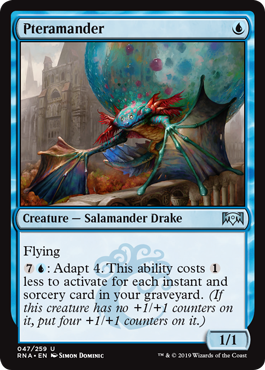 I have yet to be blown away by Reclaimer in Temur Delver, the shell I spent yesterday testing it in. But the Elf did have its moments. I'm up to 4 Scour, 4 Looting now in a bid to accelerate its development; so far, the additional cogs smooth things out considerably. They've also left me wondering if there's not a better creature to spend all that effort enabling; Etherium Pteramander again, maybe, or just Arclight Phoenix.
I have yet to be blown away by Reclaimer in Temur Delver, the shell I spent yesterday testing it in. But the Elf did have its moments. I'm up to 4 Scour, 4 Looting now in a bid to accelerate its development; so far, the additional cogs smooth things out considerably. They've also left me wondering if there's not a better creature to spend all that effort enabling; Etherium Pteramander again, maybe, or just Arclight Phoenix.
And the Beat Goes On
In any case, M20 spoilers have only just begun. Here's hoping we get another promising one-mana combat creature to put through the evaluation ringer. In the meantime, have any new cards tickled your aggro-deck brewing bone?




